Are you ready to increase your blog traffic by creating a content strategy that uses the best SEO tactics in 2018?
Great! Because without blogs that rank highly on Google, get shared on social media, and leave a lasting impact on their viewers, even the most well-intentioned marketing strategies will fail.
That said, lately there’s been a ton of chatter within the HubSpot and Inbound communities about the evolution of SEO and its effects on how marketers strategize and develop website content from this point forward.
These talks have opened the floodgates on content marketing and search engine optimization tactics both new and old like pillar pages, latent semantic keywords, video, building backlinks and more.
A few of these “new” marketing tactics have been part of some marketer’s tool belts for quite a while but they’re making their mainstream comeback and becoming a staple of many small businesses' strategies in 2018.
In this post, we’re going to cover how you can apply each of these tactics in your own blogging strategy to achieve massive growth!
The seven techniques we’ll discuss are:
- How to Create Quality Content
- Adapting to the Evolution of Google Search
- Creating Pillar Pages and Topic Clusters
- Using Latent Semantic Indexing (LSI) Keywords
- Embedding Videos to Increase Time on Page and Dwell Time
- How to Generate Quality Backlinks
- Becoming Awesome at Optimizing Existing Blog Posts
1. Create Quality Content
I know, you’ve heard this one countless times before. But the fact of the matter is: creating high quality content is the price of entry if you want your website to rank well in 2018.
This is so true that the phrase “content is king” might as well be considered an adage these days.
Whether you’re a content marketing newbie or a blogging pro, following a few guidelines will ensure your content is the best time and time again.
Understand Your Buyer Personas
All successful content meets a specific need of its readers. This could mean helping the reader solve a problem, educating them on a specific topic or entertaining him/her with humor or motivation. Whatever the need, it’s imperative that you uncover it and create the best resource available for addressing that specific need.
Developing buyer personas for your business is a great way to ensure you fully understand the needs of your website visitors. If you're unfamiliar with the concept, a buyer persona is a semi-fictional representation of your business’s ideal customers.
You’ll want to take your time during the buyer persona creation process. Your research should be based on actual data obtained through customer interviews, one-on-one meetings with your Sales team members, CRM data and other forms of market research.
Make sure you ask the right persona development questions and leave no stone unturned. Getting these correct is at the core of attracting the right visitors to your website.
Make Your Content Visually Appealing
It’s 2018 and the number of businesses and influencers using blogging as part of their marketing strategies has reached an all-time high.
The competition is fierce and only the best will prevail. Creating content with personas in mind is a great start, but it’s equally important for that content to look good too. According to Quick Sprout, “content with relevant images gets 94% more views than content without.” Holy cow — that’s almost double the views!
In addition to increasing your number of blog views, adding high-quality images to your content gives you the opportunity to provide additional information and increase on-page engagement.
Learn How to Create Amazing Headlines
Learning how to write great blog headlines is an essential skill for content marketers.
Think about it: when your blog shows up in the SERPs, the only things differentiating it from its 9+ competitors are the page’s meta description and page title AKA headline.
Excluding SERP features, all of the results are formatted the same, use the same colors, and are allotted the same amount of real estate. You get the point; it's basically impossible to overstate the importance of creating headlines people want to click.
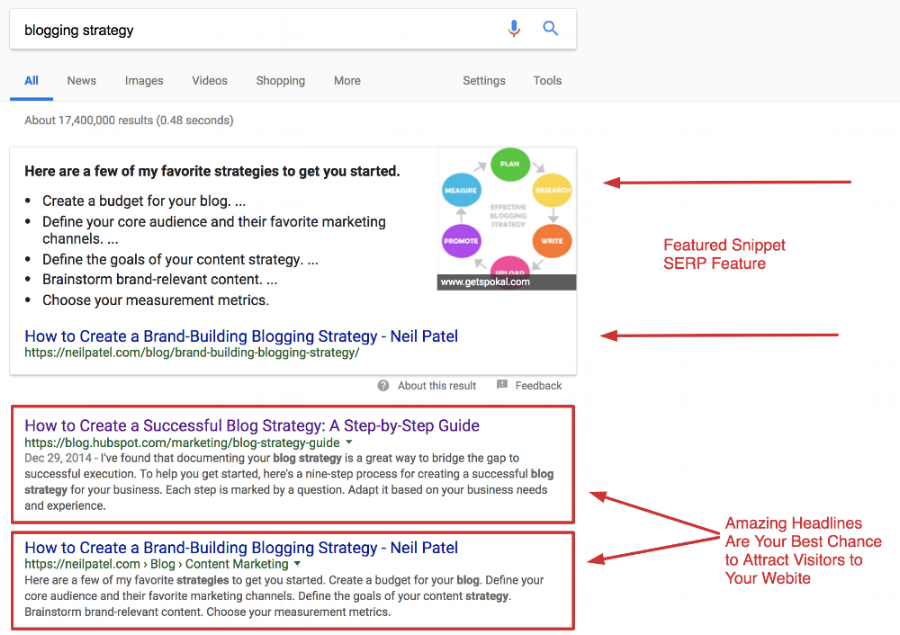
When I’m creating blog titles there are two techniques that work best for me.
First, I analyze the search results page for the topic or keyword I want the blog to rank for. While analyzing the results, I look at the headlines for the top search results, both paid and organic. Since Google already ranks these pages in the top spots, they’re a great starting point for my own blog headline ideas.
After I have a general idea for my blog headline, I head over to CoSchedule’s Headline Analyzer.

If you want to write headlines that drive traffic and social shares, I highly recommend testing this tool out. It’s free to use and quickly analyzes your headlines for structure, readability, grammar, length, sentiment and more. It even shows you what your headline will look like in Google Search and as an email subject line.
I usually test 10-15 different variations of my initial headline until I receive a score of at least 70-75.
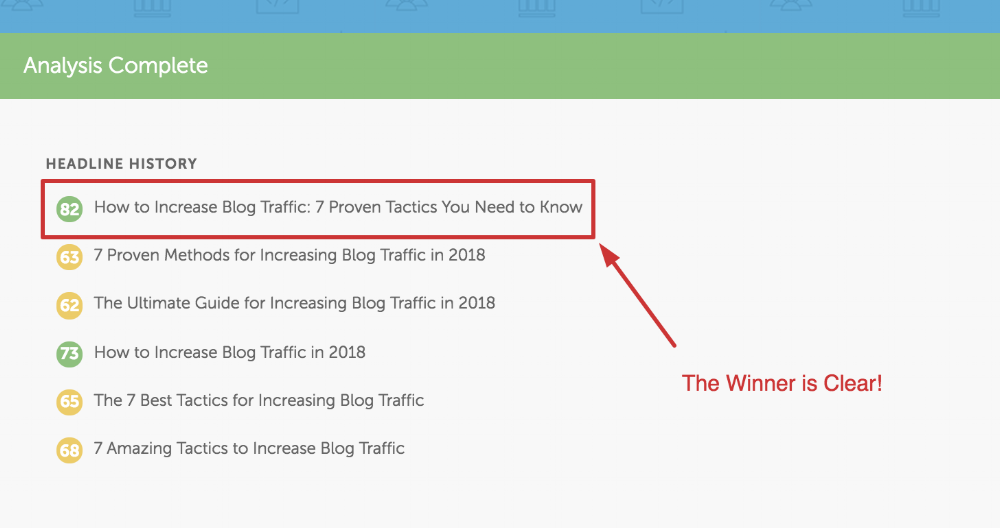
This process has helped me and the Bluleadz team create headlines that generate results for our clients.
Create Evergreen Content
In SEO and content marketing, “evergreen content” refers to content that is always relevant. Evergreen posts generate traffic long after they’re published. Because of their sustained success, these are the posts that are behind case studies where organic traffic growth compounds year after year.
You can start creating your own evergreen content by making list posts, how to posts, top tip posts and more. Just avoid topics like current events, news stories, and other seasonal trends.
2. Adapt to the Evolution of Google Search
Over the last several years, Google has released a host of updates focused on improving the experience of its users by better organizing and showcasing helpful content. While each update has contributed to the evolution of SEO, two in particular have impacted marketing strategies the most.
Notable Search Algorithm Update #1: Hummingbird
Release date: August 2013
How it affected SEO: Hummingbird improved Google search results by parsing out phrases rather than specific keywords.
It increased the relevancy of search results by forming semantic relationships between topics and sub-topics. This resulted in a huge shift in the way searchers used (and currently use) Google.
Hummingbird made Google Search more conversational, less robotic and ultimately set the stage for voice search.
Notable Search Algorithm Update #2: RankBrain
Release date: 2015
How it affected SEO: RankBrain is Google’s machine learning powered artificial intelligence system that interprets users' searches to uncover underlying intent.
This allows Google to return relevant search results that might not use the exact words the user searched for. The process is made possible by Google’s ability to associate past search history with similar themes. Combine this with the software’s power to pull together keywords and phrases, and you have the recipe for better, more contextual search results.
Hummingbird and RankBrain have enhanced the capability of Google Search, which means marketers like you and me need to adapt our blogging strategies as soon as possible if we want to get our blogs noticed by Google . This is where pillar pages and topic clusters come into play.
3. Create Pillar Pages and Topic Clusters
The main idea behind a pillar page is to create a helpful, positive user experience that solves for both the searcher (visitors to your blog) and the search engine (Google).
To do this, you should develop your pillar page strategy by creating targeted “clusters” of content, each one covering a specific topic in-depth. The content from these clusters leads to a centralized hub, known as the content pillar.
By creating highly focused topic clusters, you will increase your website’s relevance on each subject area, which is essential to attract more qualified visitors to your blog.
To better explain this idea and provide insight on how to create a pillar page, let’s take a closer look at a topic cluster example from HubSpot:
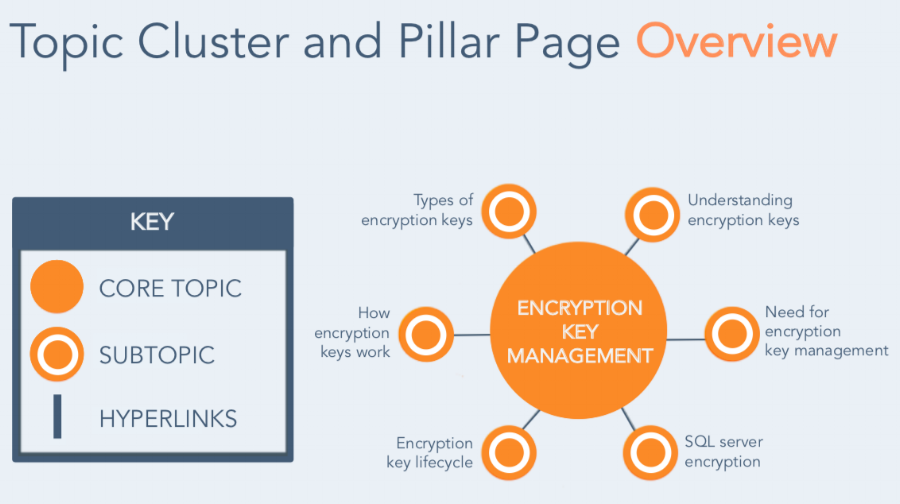
In this example, the core topic, encryption key management, is the topic you would ultimately attempt to rank for on Google.
Core topics are broad, highly searched for terms that can be explained on a deep level and ultimately take the shape of your pillar page.
The sub-topics that make up the topic cluster are all closely related to (and support) your core topic but are unique enough to stand on their own as individual blog posts, videos or website pages.
One of the most important pillar page best practices is to ensure your entire topic cluster is connected via internal links. This means each piece of subtopic content needs to link back to the pillar page.
4. Use Latent Semantic Indexing (LSI) Keywords
I remember seeing a lot of hype around the "death of keywords" when HubSpot initially started promoting the topic cluster SEO model.
Thankfully for keywords, they’re still alive and thriving today. In fact, keyword research is an essential part of the process when using blogs to drive website traffic.
It just so happens that thanks to Hummingbird, RankBrain and the evolution of search, the keyword techniques that worked in 2012 are a thing of the past. Enter latent semantic indexing keywords.
So, what is latent semantic indexing anyway?
In short, LSI is a technique search engines like Google use to discover how a term and content work together to mean the same thing.
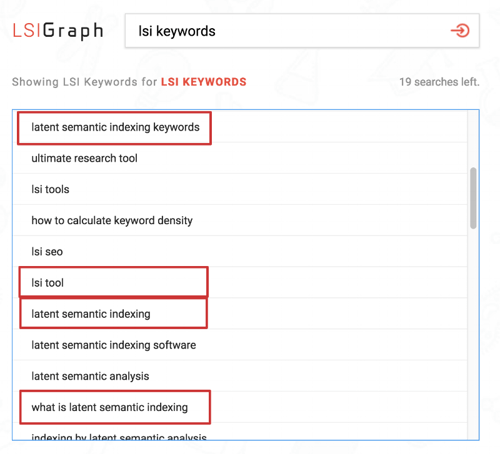
This helps search engines easily identify related words and concepts throughout your web page’s content and deliver the right content to searchers.
To improve your blog, check out this free LSI tool.
5. Embed Videos to Increase Time on Page and Dwell Time
You’ve been hearing about the importance of video in marketing for a few years now. And you’re likely familiar with using video to improve SEO by creating awesome videos on your company’s YouTube channel. You might even use video to optimize your site’s landing and thank you pages.
But did you know you can use the videos you’re creating to optimize your blog posts and improve important metrics for SEO?
Embedding relevant and engaging videos in your blog posts can help boost engagement metrics like time on page and dwell time.
In case your unfamiliar with these metrics:
- Time on Page is the amount of time a website visitor spends on a specific page before heading off somewhere else. This includes leaving to check out another one of your blog posts, heading over to your company’s Contact Us page or simply going back to view other search results.
- Dwell Time is the measure of time from when a user clicks your page in the search results page and then later returns back to the SERPs.
Improving user engagement metrics like these means your blog visitors are finding your content valuable, which is key to high rankings on Google and increasing organic traffic.
Capitalizing on this effective tactic is straightforward. All you need to do is head over to YouTube, Vimeo, Wistia or wherever you host your videos and start embedding them on relevant blog posts.
Keep track of the pages you add videos to and remember to use KPIs like sessions, users, time on page and bounce rate to monitor your success.
6. Generate Quality Backlinks
Building backlinks to your website will increase your domain’s trustworthiness and authority.

Understanding this concept is absolutely critical to your blogging success. Let’s take a closer look by reviewing how search engines rank your content.
While Google’s algorithm analyzes hundreds of ranking signals, there are two major factors that affect how your content is ranked.
The first major ranking factor is relevance. Content relevance is computed by how well your content matches users’ search queries. You can achieve relevance around specific topics by working on your topic cluster strategy.
The second major ranking factor is authority. Unlike relevance, you don’t build your website’s authority through content volume. Instead, you can achieve high website authority by building high-quality backlinks.
Measuring, monitoring and improving your website’s authority is important because creating great content isn’t always enough to rank at the top of Google these days.
Yes, creating compelling and unique content people naturally want to link to is important, but you also need to tell people about your content so they can find and link to it.
To generate the highest quality backlinks to your website and blog posts, you’ll want to acquire inbound links from highly authoritative websites within your niche.
A great way to do this is by responding to press alert requests using a service like Help a Reporter Out (HARO).
These sourcing services open up the door for marketers and business owners to form relationships with key influencers and journalists from big publications.
This is awesome because it not only helps you acquire quality backlinks and reach new audiences, but also potentially opens the door to new, long-lasting relationships.
To start building links to your website using HARO:
- Sign up for the service at www.helpareporter.com
- Browse the requests sent to your inbox without responding for one or two weeks
- If applicable, make a list of thought leaders in your organization who might offer quotes on relevant topics and email them for responses
- Use these quotes to help you respond to relevant press alert requests
One of the benefits of HARO link building is that you don’t need to create a new piece of content to get quality backlinks. Usually, journalists only require a few one-liners. Keep this in mind as you respond to each information request.
7. Become Awesome at Optimizing Existing Blog Posts
Optimizing and republishing old blog posts is a great way to improve your site’s SEO and drive more traffic to your blog without the need to create content from scratch.
This tactic is perfect for blog content that is at least one year old and contains outdated information or just needs some general improvements.
When refreshing old blog posts, you’ll want to focus on posts that have potential to rank higher for topics and keywords with high search volume. The best way to identify these opportunities is by compiling a list of all your blog posts and prioritizing them by highest volume of organic traffic.
Once you have this list ready, jump into Google Search Console to see where those high trafficked blog posts are ranking on Google. This is important because you want to identify the posts that are ranking on pages 2 and 3 of the Google search results. These pages have “Page One potential” and are the blogs you want to start working on.
While updating your old blog posts, keep in mind on-page SEO best practices in addition to:
- Making the post more comprehensive by adding new sections
- Adding new list items to list posts
- Expanding on existing sections with more detail
- Updating old statistics
- Creating internal links to new, related articles
Once your old blog post is new again, consider adding an Editor’s Note to the bottom to make viewers aware the post was updated, update the post’s publish date and promote it to drive additional traffic.
Conclusion
Give yourself a pat on the back because you now possess the knowledge necessary to revamp your strategy and increase blog traffic this year and for years to come.
When executed with consistency, the seven tactics outlined above will absolutely move the needle for your business.
Did we leave out some of your favorite ways to boost blog traffic? Let us know in the comments!

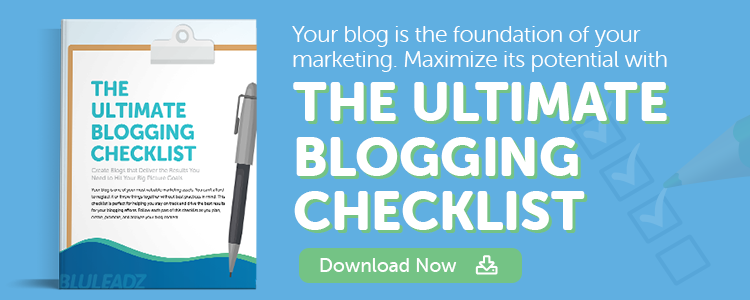
William Polliard